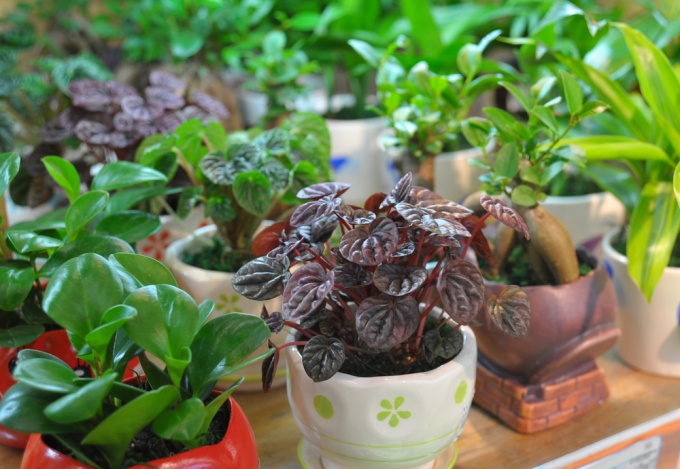Instruction
1
Pay attention to his appearance. In cereal plants long, narrow leaves. They are not very attractive, so not popular.
From bushy plants out of the ground usually comes out a few stems, they not only grow in height or width. Some of them can be small and compact (begonia, Maranta, peperomiya, Coleus, saw), others are spreading and high (aukuba abutilon).
Plants with erect stems have a straight vertical stem, which often rests on the ceiling. Among them, a columnar (columnar stem without leaves): different kinds of cacti and Haworthia. Trees have a Central branching stem. The leaves are petiolate. The most common of this group of ficus, schefflera, citrus, Laurel, codiaeum (Croton). The bases of fallen leaves covered the stem about trees. Young leaves are located only on the top: dieffenbachia, dracaena, pandanus, Yucca.
The stems of vines and a basket of plants down the sides of the pot or require support: ivy, money plant, and some species of ficus and philodendron, fittonia, stonecrop Morgan,Cissus, syngonium.
From the rosette plants, the leaves close together at one point. Most of these flowers are not high: Saintpaulia, Primula, gloxinia, sansevieriya, houseleek, aloe, vriesea, aechmea, Chlorophytum.
From bushy plants out of the ground usually comes out a few stems, they not only grow in height or width. Some of them can be small and compact (begonia, Maranta, peperomiya, Coleus, saw), others are spreading and high (aukuba abutilon).
Plants with erect stems have a straight vertical stem, which often rests on the ceiling. Among them, a columnar (columnar stem without leaves): different kinds of cacti and Haworthia. Trees have a Central branching stem. The leaves are petiolate. The most common of this group of ficus, schefflera, citrus, Laurel, codiaeum (Croton). The bases of fallen leaves covered the stem about trees. Young leaves are located only on the top: dieffenbachia, dracaena, pandanus, Yucca.
The stems of vines and a basket of plants down the sides of the pot or require support: ivy, money plant, and some species of ficus and philodendron, fittonia, stonecrop Morgan,Cissus, syngonium.
From the rosette plants, the leaves close together at one point. Most of these flowers are not high: Saintpaulia, Primula, gloxinia, sansevieriya, houseleek, aloe, vriesea, aechmea, Chlorophytum.
2
Look at the leaves of the flower. If they are long, sharp, spear-shaped, it can be aglaonema, calathea, aspidistra.
If the leaves with the outline of a star or palchatorazdelnye, it could be an abutilon, Cissus, begonias, geraniums, fats, philodendron, ivy.
If the leaf is like a feather, it could be asparagus, jacaranda, Mimosa,Nephrolepis, pteris, Radermacher.
If the plant looks like a palm tree, it could be washingtonia, coconut, dates, chamaedorea, howea.
If palchatorazdelnye leaves collected on top of the stem, it can be dizigoteka, schefflera, tsiperus.
If the base of the leaves cover the upper part or all of the stem, then it might be dieffenbachia, dracaena, pandanus, Yucca, bokarneya.
If the leaves are oblong-lanceolate or ovate, with a reverse side of the sheet purple colored with pronounced veins and sit on a short stem, it may be arrowroot, stromanta, ctenanthe, calathea.
Monstera recognized for deep cuts and holes in large sheets.
If the leaves with the outline of a star or palchatorazdelnye, it could be an abutilon, Cissus, begonias, geraniums, fats, philodendron, ivy.
If the leaf is like a feather, it could be asparagus, jacaranda, Mimosa,Nephrolepis, pteris, Radermacher.
If the plant looks like a palm tree, it could be washingtonia, coconut, dates, chamaedorea, howea.
If palchatorazdelnye leaves collected on top of the stem, it can be dizigoteka, schefflera, tsiperus.
If the base of the leaves cover the upper part or all of the stem, then it might be dieffenbachia, dracaena, pandanus, Yucca, bokarneya.
If the leaves are oblong-lanceolate or ovate, with a reverse side of the sheet purple colored with pronounced veins and sit on a short stem, it may be arrowroot, stromanta, ctenanthe, calathea.
Monstera recognized for deep cuts and holes in large sheets.
3
Learn the features of a flower.
Tillandsia does not require irrigation, is nourished by air.
Agave, hibiscus, cactus, poinsettia, oleander, citrus wither in a dark corner, they begin to fall off the leaves.
But sansevieriya, epipremnum quietly tolerate shade and do not like bright sun.
Have arrowroot in dry hot weather they fold the tube sheets.
But gipoestes, fittonia, Coleus, codiaeum have a decorative spotted leaves.
Oksalis their leaves butterfly closes for the night.
Tillandsia does not require irrigation, is nourished by air.
Agave, hibiscus, cactus, poinsettia, oleander, citrus wither in a dark corner, they begin to fall off the leaves.
But sansevieriya, epipremnum quietly tolerate shade and do not like bright sun.
Have arrowroot in dry hot weather they fold the tube sheets.
But gipoestes, fittonia, Coleus, codiaeum have a decorative spotted leaves.
Oksalis their leaves butterfly closes for the night.
4
For a more precise definition of the name of this flower please refer to the book of Dr. D. G. Hessayon "Everything about room plants. You can also use the book by V. V. Vorontsov, "Indoor plants".
Useful advice
Before you buy a flower, find out the name about its features. This will help you to properly care for it.
If you have an unfamiliar flower and you are unable to determine its name, then be especially careful.
If you have an unfamiliar flower and you are unable to determine its name, then be especially careful.
